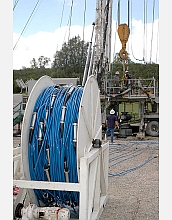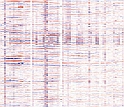|

Press Release 06-063
Volcano-like Tremors Detected Deep Within Earth's Crust Near San Andreas

Rumbles are attributed to plate shifts, not volcanic activity
April 12, 2006
Tremors within the Earth are usually--but not always--related to the activity of a volcano. Now, such vibrations have been recorded nowhere near a volcano, but at a geologic observatory at the San Andreas Fault. Scientists believe the fault tremors may be related to activity at a subduction zone--a place where one of Earth's constantly moving tectonic plates slips beneath another.
To determine whether the San Andreas Fault is moving with the tremors, scientists with the San Andreas Fault Observatory at Depth (SAFOD) are installing instruments to measure the tremors' activity. Located near Parkfield, Calif., SAFOD is part of the EarthScope Project, an effort to study the North American continent's geology.
"Unlike the sharp jolt of an earthquake, tremors within Earth's crust emerge slowly, rumbling for longer periods of time," said Kaye Shedlock, program director for EarthScope at the National Science Foundation (NSF), which funds the project. "Although not in this case, tremors are usually produced by magma moving in cracks or other conduits beneath a volcano."
The rumblings are the first recordings of non-volcanic tremors in a deep borehole, providing scientists with data to better understand such mysterious underground movements.
The results will help geologists understand whether the deeply buried rocks of the San Andreas Fault - which are derived from an ancient subduction zone - behave in a similar way to the rocks of the Cascadia Subduction Zone, still active today.
"In the Cascadia Subduction Zone off the Pacific Northwest, for example, tremors are associated with the slow slip of the undersea Juan de Fuca tectonic plate as it submerges beneath the North American tectonic plate," said Greg van der Vink, EarthScope facility project director.
-NSF-

Media Contacts
Cheryl Dybas, NSF (703) 292-7734 cdybas@nsf.gov
Charna Meth, EarthScope (202) 682-0633 cmeth@earthscope.org
Related Websites
EarthScope Project: http://www.earthscope.org

The National Science Foundation (NSF) is an independent federal agency that supports fundamental research and education across all fields of science and engineering. In fiscal year (FY) 2009, its budget is $9.5 billion, which includes $3.0 billion provided through the American Recovery and Reinvestment Act. NSF funds reach all 50 states through grants to over 1,900 universities and institutions. Each year, NSF receives about 44,400 competitive requests for funding, and makes over 11,500 new funding awards. NSF also awards over $400 million in professional and service contracts yearly.
 Get News Updates by Email Get News Updates by Email
Useful NSF Web Sites:
NSF Home Page: http://www.nsf.gov
NSF News: http://www.nsf.gov/news/
For the News Media: http://www.nsf.gov/news/newsroom.jsp
Science and Engineering Statistics: http://www.nsf.gov/statistics/
Awards Searches: http://www.nsf.gov/awardsearch/
| 


